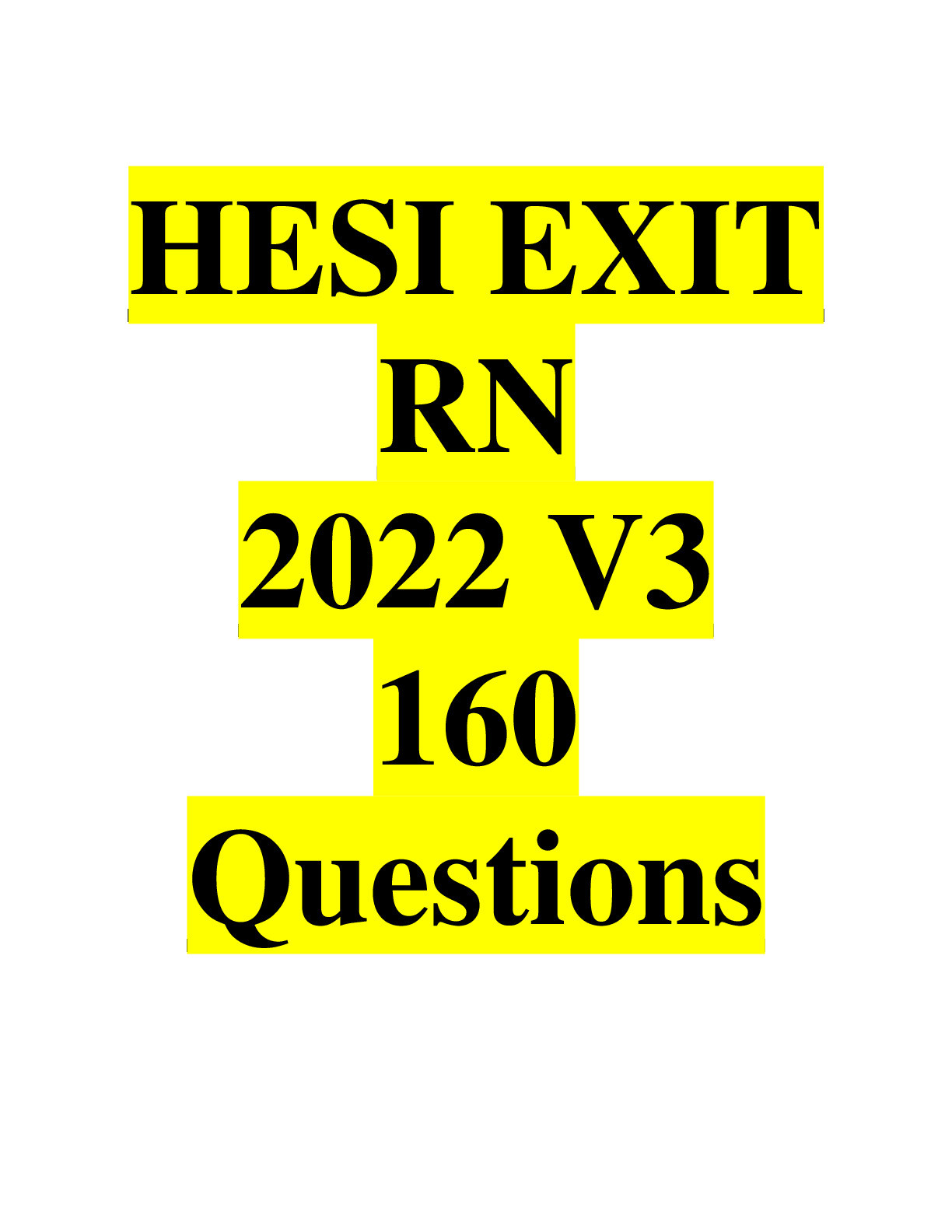All study resources > HESI EXIT RN 2022 V3 160 Questions (Nursing)
HESI EXIT RN 2022 V3 160 Questions
1. A male client with stomach cancer returns to the unit following a total gastrectomy. He has a nasogastric tube to suction and is receiving Lactated Ringer’s solution at 75 mL/hour IV. One hour after admission to the unit, the nurse notes 300 mL of blood in the suction canister, the client’s heart rate is 155 beats/minute, and his blood pressure is 78/48 mmHg. In addition to reporting the fi
...[Show More]
1. A male client with stomach cancer returns to the unit following a total gastrectomy. He has a nasogastric tube to suction and is receiving Lactated Ringer’s solution at 75 mL/hour IV. One hour after admission to the unit, the nurse notes 300 mL of blood in the suction canister, the client’s heart rate is 155 beats/minute, and his blood pressure is 78/48 mmHg. In addition to reporting the finding to the surgeon. Which action should the nurse implement first?
a. Measure and document the client’s urinary output.
b. Request the client’s reserved unit if packed red blood cells.
c. Prepare the placement of a central venous catheter. d. Increase the infusion rate of Lactated Ringer’s solution.
2. an adult male who fell 20 feet from the roof of this home has multiple injuries, including a right pneumothorax. Chest tubes were inserted in the emergency department prior to his transfer to the intensive care unit (ICU). the nurse notes that the suction control chamber is bubbling at the
- 10 cm H2O mark, with fluctuation in the water seal, and over the past hour 75 ml of bright red blood is measured in the collection chamber. Which intervention should the nurse implement? a. Add sterile water to the suction control chamber.
b. Give blood from the collection chamber as autotransfusion
c. Manipulate blood in tubing to drain into chamber.
d. Increase wall suction to eliminate fluctuation in water seal.
3. A client who received hemodialysis yesterday is experiencing a blood pressure of 200/100 mmHg, heart rate 110 beats/minute, and respiratory rate 36 breaths/minute. The client is manifesting shortness of breath, bilateral 2+ pedal edema, and an oxygen saturation on room air of 89%. Which action should the nurse take first?
a. Elevate the foot of the bed.
b. Restrict the client’s fluid. c. Begin supplemental oxygen.
d. Prepare the client for hemodialysis.
4. A client with Addison’s crisis is admitted for treatment with adrenal cortical supplementation. Based on the client’s admitting diagnosis, which findings require immediate action by the nurse? (Select all that apply)
a. Headache and tremors
b. Irregular heart rate
c. Skin hyperpigmentation
d. Postural hypotension
e. Pallor and diaphoresis
5. An older client is admitted with fluid volume deficit and dehydration. Which assessment finding is the best indicator of hydration that the nurse should report to the healthcare provider?
a. Urine specific gravity is 1.040
b. Systolic blood pressure decreases 10 points when standing.
c. The client denies being thirsty. d. Skin tenting occurs when the client’s forearm is pinched.
6. After an inservice about electronic health record (EHR) security and safeguarding client information, the nurse observes a colleague going home with printed copies of client information in a uniform pocket. Which action should the nurse take? a. File a detailed incident report with the specific hiring facility.
b. Warn the colleague that their actions are unprofessional.
c. Comment anonymously about the action of a staff discussion board.
d. Communicate the colleague’s actions to the unit charge nurse.
7. The nurse is evaluating a tertiary prevention program for clients with cardiovascular disease implemented in a rural health clinic. Which outcome indicate the program is effective?
a. At-risk clients received an increased number of routine health screenings.
b. Clients reported having new confidence in making healthy food choices. c. Clients who incurred disease complications promptly received rehabilitation.
d. Client relapse rate of 30% in a 5-year community-wide anti-smoking campaign.
8. The nurse is caring for a client with chronic obstructive pulmonary disease (COPD) who uses oxygen at 2 L/minute per nasal cannula continuously. The nurse observes that the client is having increased shortness of breath with respirations at 23 breaths/minute. Which action should the nurse implement first?
a. Determine if the client is experiencing any anxiety.
b. Auscultate the client’s bilateral lung sounds and oxygen saturation.
c. Notify the healthcare provider about the client’s distress. d. Assess the delivery mechanism of the oxygen tank, tubing, and cannula.
9. Which statement by a client who is 24 hours post-subtotal thyroidectomy requires an immediate investigation by the nurse? a. “When I get out of bed quickly, I feel a little dizzy.”
b. “The dressing over my incision feels like it is too tight.”
c. “I’m most comfortable when the head of the bed is raised.”
d. “This IV infusion makes me urinate more often than usual.”
[Show Less]
